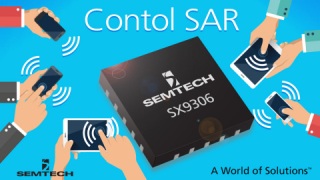Nov 11 2015
Semtech Corporation, a leading supplier of analog and mixed-signal semiconductors, today announced the SX9306, a new addition to its SX9300 family of proximity sensors that minimizes radio-frequency (RF) exposure by selectively reducing radio-frequency power in mobile phones and tablets.
 Semtech Launches Proximity Sensor to Enable Smart Phone and Tablet Makers to Minimize Radio Frequency Exposure in Next Generation Handheld Products. (Graphic: Business Wire)
Semtech Launches Proximity Sensor to Enable Smart Phone and Tablet Makers to Minimize Radio Frequency Exposure in Next Generation Handheld Products. (Graphic: Business Wire)
The SX9306 is an ultra-low power, capacitive proximity sensor with an on-chip smart engine for human body detection and advanced SAR (Specific Absorption Rate) control.
SAR is the measure of the amount of RF power that is radiated into the human body when in a close proximity to a mobile device. In the U.S., SAR standards are set by the Federal Communications Commission (FCC) and these limits are often followed by other countries around the world. In Europe, the standard is set by CENELEC. In China, the standard is set by TENAA.
The on-chip smart engine can detect the permittivity of different surfaces, giving it the ability to accurately discriminate between inanimate objects or human body.
Smart Phone manufacturers use this capability to program their devices to reduce RF emission power when a device is near a human body part. With higher RF-power devices and more extensive device usage, the SX9306 allows these manufacturers to proactively reduce SAR without affecting RF strength during normal usage.
The SX9306 is part of Semtech’s SX9300 smart proximity sensing platform. The part has four high-resolution capacitive sensor inputs with sensing resolution of 0.08 femto-farad (fF). Each sensor also features a capacitance-offset compensation of up to 30 picofarads (pF). With its integrated RF shield, the device provides very robust noise immunity and eliminates false triggers that commonly occur in these applications.
“The pervasiveness of smart devices and their usage has triggered an incredible revolution in the habit of human population world-wide. All manufacturers are looking at ways to reduce SAR without impacting the consumer’s experience, which makes proximity sensors an ideal alternative,” said David Wong, Product Line Director of Semtech Consumer Sensing Product Groups. “The SX9306 is our new flagship SAR proximity sensor because it offers the resolution and power draw required to seamlessly control RF performance without the user being disconnected or experiencing a weak signal.”
The SX9306 is available in two space-saving packages, a 3mm x 3mm thin QFN package or a 1.63mm x 1.23 mm WLCSP package.
Key Features of the SX9306
- 2.7V – 5.5V input supply voltage
- Up to 4 capacitive sensor inputs
- Patented on-chip smart engine for human detection and advanced SAR control
- High-resolution capacitive sensing down to 0.08fF
- Capacitance offset compensation up to 30pF
- Integrated RF shield for enhanced noise immunity
- Ultra-low power consumption
- 400kHz I2C serial interface
- Input levels compatible with 1.8V host processors
- -40°C to +85°C operation
- 1.63x1.23 mm WLCSP or 3x3mm thin QFN package
Pricing and Availability
The SX9306 product is available immediately in production quantities and is priced at $0.81 each for WLCSP (order code: SX9306ICSTRT) and $0.72 each for QFN (order code: SX9306IULTRT) in 1,000-piece lots. Semtech offers comprehensive design assistance, including field- and factory-based support. Data sheets, volume pricing, and delivery quotes, as well as evaluation kits and samples, are available at www.semtech.com/info.